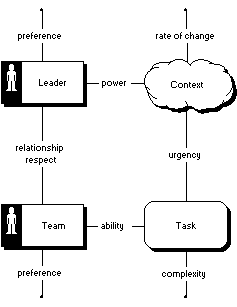
 |
leadershipveryard projects > business organization management > leadership |
| we offer | three theories of leadership | on this page | other material | ||||||
| consultancy
management briefings and technical education independent advice on tools and methods |
|
Quotes | Blog - Leadership
and Change
Leadership and Control (pdf) |
 |
Leadership Characteristicsveryard projects > leadership > traits |
| Intelligence | Problem-Solving Ability, Understanding, Decisiveness | |
| Character | Drive, Initiative, Confidence | |
| Physique | Health, Height, Handsome | |
| Social Category | Statistics indicate that gender, social class and ethnic origins can affect a person's chances of becoming a leader. In the past, there were many leadership positions that were only accessible to men who had attended the right school or university. Nowadays, the advantages of belonging to the right social category have been considerably diminished, but we are not yet in a fully egalitarian and meritocratic society. |
 |
Styles of Leadershipveryard projects > leadership > styles |
| dictatorship / coercion |
v |
democracy / persuasion |
Here are some further style classifications and spectra, proposed by
various authors.
| People-Oriented, Task-Oriented | |
| Autocratic (Exploitative / Benevolent), Participative, Democratic | |
| Tells, Sells, Consults, Joins | |
| Country Club, Team, Middle-of-the-Road, Impoverished, Authority / Compliance | |
| Telling, Selling, Participating, Delegating | |
| Artist, Craftsman, Technocrat |
 |
Contingency Theory of Leadershipveryard projects > leadership > contingency |
|
|
|
||||||||||||
|
|
| Thus different points on the style spectrum are appropriate for different
situations. Management writers including Fiedler, Tannenbaum and Handy
have identified various factors as relevant. The diagram represents
a combination of these factors.
Fred Fielder, ‘Engineer the job to fit the manager’ Harvard Business Review 5, 1965 Robert Tannenbaum & Warren Schmidt, ‘How to choose a leadership pattern’ Harvard Business Review 2, 1958 Charles Handy, Understanding
Organizations (Harmondsworth: Penguin, 1976) pp 96 ff
|
 |
| Enterprise design should be based on an assessment of the complexity of a given task, together with an assessment of the urgency of a given requirement for change. | |
| Design tasks to fit the abilities of the team. Each team should have some simple and some complex tasks. Design organizations and systems with a mix of leadership styles, so that the organization culture is not fixed at either end. | |
| Moving towards the participative end of the spectrum is valuable for several reasons. It improves the quality of working life for the team, which is in turn likely to have a good effect on the quality and productivity of their work. It also reduces supervision costs and increases bottom-up organizational learning. However, if the organizational culture is fixed at the participative end of the leadership spectrum, this may make it more difficult in future to impose top-down change. | |
| The implementation of complex systems is usually a highly complex task, and requires the knowledge and skills of the ‘followers’ as well as the ‘leaders’. However, radical change is often prompted by organizational crisis. In such circumstances, there may be little opportunity for extensive discussion and participation. | |
| Avoid simply dividing people into ‘leaders’ and ‘followers’. Consider multiple leadership patterns (distribution of authority), where not all leadership roles reside in one person/agent. (For example, one person may have technical authority, in the sense of being deferred to for technical decisions, without having direct control over investment.) | |
| If people are able to acquire leadership positions gradually, rather than all at once, this increases opportunities for personal growth, to both individual and collective advantage. |
| Three Notions of Contingency |
 |
Leadership Quotesveryard projects > leadership > quotes |
| “It is said that there was once a young platoon officer who was believed by his commanding officer to be inclined to run away in battles. This belief was shared by the men in the platoon, not without reason. But the men liked this young officer and wished him no harm. They therefore backed him up stoutly on the battlefield so that he should feel less inclined to run away. The commanding officer was uneasy about this platoon officer and as soon as possible replaced him with another young officer about whose braveness there was no possible question. When the platoon went into action the new platoon commander was as brave as expected. But now the men ran away.” [p 215] | |
| “A man caught on the rebound from failure can be a wonderful investment … An opportunity to reestablish himself in his own esteem, when he has forfeited it, is something for which a man will give you a great deal in return.” [pp 220-221] | |
| “ ‘This is unlike you’ can be far more effective and much less damaging to your relationship than ‘There you go again, you useless so-and-so’.” [p 221] |
 |
Books on Leadershipveryard projects > leadership > books |
 |
 |
Leadership Linksveryard projects > leadership > links |

|